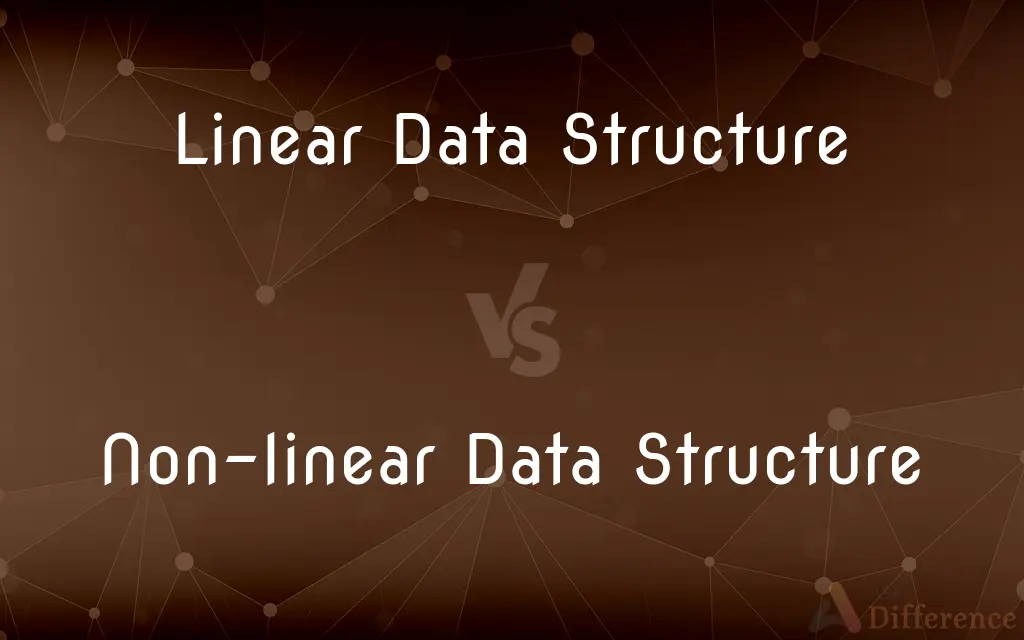Linear Data Structure vs. Non-linear Data Structure — What's the Difference?
By Tayyaba Rehman — Published on December 17, 2023
Linear Data Structure stores elements sequentially, allowing single-level traversal. Non-linear Data Structure, however, stores elements hierarchically or multi-dimensionally, allowing multi-level traversal.

Difference Between Linear Data Structure and Non-linear Data Structure
Table of Contents
ADVERTISEMENT
Key Differences
Linear Data Structure is a structure where data elements are arranged sequentially, and each item has a unique predecessor and successor except the first and last elements. Non-linear Data Structure, on the other hand, does not have a sequence and might have multiple predecessors or successors.
In Linear Data Structure, the elements are stored in a way that there are specific and direct ways to reach an element, typically via indices or positions. Non-linear Data Structure's elements can be accessed in multiple ways depending on their relationships and positions in the structure.
Linear Data Structure is simpler in terms of design and understanding. It includes arrays, linked lists, and stacks. Non-linear Data Structure is complex and includes trees and graphs. The relationships among elements in Non-linear Data Structure can be multi-dimensional.
The operations in Linear Data Structure usually involve iterating over the entire set or a subset of elements in a straightforward manner. In Non-linear Data Structure, the operations can traverse different paths or depths, often requiring recursive strategies.
Memory utilization in Linear Data Structure is more predictable, often based on the length of the data. In Non-linear Data Structure, the memory consumption can be dynamic and varies depending on the branching factor or connections among elements.
ADVERTISEMENT
Comparison Chart
Basic Design
Sequential arrangement of elements
Hierarchical or multi-dimensional arrangement
Accessibility
Direct, using indices or positions
Multiple ways based on relationships
Examples
Arrays, linked lists, stacks
Trees, graphs
Traversal Strategy
Iterative, single-level
Recursive, multi-level
Complexity
Simpler in design and operations
More complex due to relationships
Compare with Definitions
Linear Data Structure
In Linear Data Structure, each item (except the first and last) has one predecessor and one successor.
In a linked list, every node links to the next node, forming a Linear Data Structure.
Non-linear Data Structure
Non-linear Data Structure arranges data elements in a hierarchical manner.
Trees store data hierarchically, making them a Non-linear Data Structure.
Linear Data Structure
Linear Data Structure organizes data elements in a sequence.
An array is a common type of Linear Data Structure.
Non-linear Data Structure
Non-linear Data Structure can have multi-level traversals.
Binary trees, a type of Non-linear Data Structure, can be traversed in-depth using recursive strategies.
Linear Data Structure
Linear Data Structure allows for straightforward, single-level traversal.
Stacks, a type of Linear Data Structure, follow a last-in-first-out (LIFO) approach.
Non-linear Data Structure
Operations in Non-linear Data Structure involve traversing through multiple paths or depths.
Searching in a graph, a Non-linear Data Structure, might involve exploring various paths to find a node.
Linear Data Structure
Operations in Linear Data Structure often involve iterating over its elements.
Searching in an array, a Linear Data Structure, might require scanning each element sequentially.
Non-linear Data Structure
In Non-linear Data Structure, an element can have multiple relationships.
In graphs, a Non-linear Data Structure, a node can connect to multiple other nodes.
Linear Data Structure
Linear Data Structure has consistent memory allocation based on its size.
A queue, a Linear Data Structure, allows data to be processed in first-in-first-out (FIFO) order.
Non-linear Data Structure
Non-linear Data Structure can have dynamic memory allocation based on relationships.
A binary search tree, a Non-linear Data Structure, allocates memory based on the number of nodes and their hierarchical placement.
Common Curiosities
Can you give an example of Linear Data Structure?
Yes, an array and linked list are examples of Linear Data Structure.
How is Non-linear Data Structure different in design?
Non-linear Data Structure organizes elements hierarchically or multi-dimensionally.
Is memory allocation predictable in Linear Data Structure?
Yes, it's often consistent based on its size.
Which Data Structure is more suitable for hierarchical data representation?
Non-linear Data Structure is ideal for hierarchical data representation.
What is the primary design of a Linear Data Structure?
Linear Data Structure arranges elements in a sequential manner.
How is traversal different in Linear Data Structure compared to Non-linear?
In Linear Data Structure, traversal is single-level, while in Non-linear Data Structure, it can be multi-level.
Which Data Structure can be traversed recursively, Linear or Non-linear?
Non-linear Data Structure can often be traversed recursively.
What's a common Non-linear Data Structure example?
Trees and graphs are examples of Non-linear Data Structure.
How are elements accessed in Linear Data Structure?
Directly, often using indices or positions.
How does memory allocation in Non-linear Data Structure work?
It can be dynamic, depending on the relationships among elements.
Are operations in Linear Data Structure simpler than Non-linear?
Generally, yes. Linear Data Structure operations are straightforward, while Non-linear can be more complex.
In a Non-linear Data Structure, how are elements accessed?
In multiple ways, depending on their relationships and positions in the structure.
Do all elements in Linear Data Structure have a unique predecessor and successor?
Yes, except the first and last elements.
Can an element in Non-linear Data Structure have multiple predecessors or successors?
Yes, depending on its relationships within the structure.
Are arrays a type of Linear or Non-linear Data Structure?
Arrays are a type of Linear Data Structure.
Share Your Discovery

Previous Comparison
Allopatric Speciation vs. Sympatric Speciation
Next Comparison
Advertising vs. Public RelationsAuthor Spotlight
Written by
Tayyaba RehmanTayyaba Rehman is a distinguished writer, currently serving as a primary contributor to askdifference.com. As a researcher in semantics and etymology, Tayyaba's passion for the complexity of languages and their distinctions has found a perfect home on the platform. Tayyaba delves into the intricacies of language, distinguishing between commonly confused words and phrases, thereby providing clarity for readers worldwide.












































